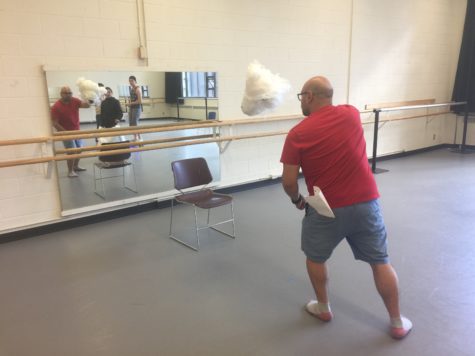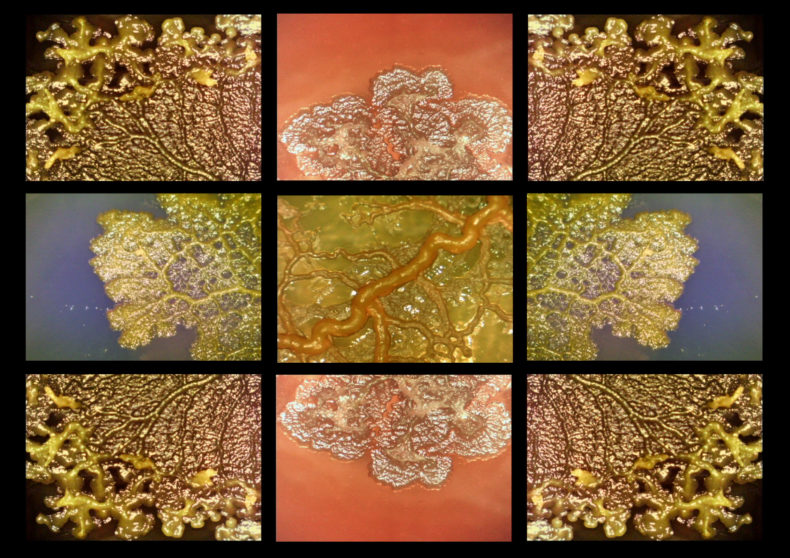We’re in the very near future, on a quiet beach, with seven young interns from the Third Annual Slime Crisis Conference. In many ways, this conference is like any other; there are misunderstandings, arguments, and moments of insight. There’s some weird food, and some sleeping around.
This conference, though, isn’t just for humans. It’s for representatives of almost every species on the planet, and it aims to save life on earth from a toxic slime that, accelerated by climate change, is quickly taking over the oceans. The interns are studying various animal languages—toad, dolphin, seal, seabird—and they’re here to translate for the delegates. “We’re second-generation animal communicators,” one intern says proudly. “So, like, linguistically evolved.”
This is the premise of SLIME, a play by Bryony Lavery that makes its world premiere next week at the Banff Centre for Arts and Creativity. I first heard about Lavery’s idea back in the spring of 2016, when I was teaching at the Banff Centre, and I was immediately intrigued. Environmental thinkers sometimes dream of communicating with other species about our common problems and shared fates, but few have imagined the everyday practicalities: who would translate? Who would speak first? And what in the world would we all eat for lunch?
Lavery’s answers to these questions are funny, tragic, and thought-provoking. There are jellyfish cupcakes—or are they jellyfish that happen to look like cupcakes?—and an ex-circus polar bear with a smoking habit. During rehearsals, the seven actors who play the interns listened to recordings of the species whose sounds they translate, guessing at how, for instance, an otter might say, “What’s that nearing scaring thing?” The production intended to use the recordings in the performance, says director Kendra Fanconi, but eventually decided to use the actors’ own approximations. “We just found it so compelling to watch humans try, really hard, to communicate with animals,” says Fanconi.
Within the world of the play, some species aren’t represented at the conference because they’ve gone extinct,  and their silences fill the periodic roll call. Much of the talk among the delegates is lost in translation, and much of what does get through is painful. “We are not blamers,” begins one intern, translating for a delegation of Pacific atoll fish. “But … you put shit in our us. Our cleaning fish have been cleaning, but cannot clean all your shit. You are helping Slime to kill us!”
and their silences fill the periodic roll call. Much of the talk among the delegates is lost in translation, and much of what does get through is painful. “We are not blamers,” begins one intern, translating for a delegation of Pacific atoll fish. “But … you put shit in our us. Our cleaning fish have been cleaning, but cannot clean all your shit. You are helping Slime to kill us!”
The interns, too, are struggling to communicate; they’re enraged by their human elders’ hypocrisy, and often tell them exactly what they don’t want to hear. (The interns’ futuristic costumes are partly inspired by the student gun-safety activists from Parkland, Florida: “I didn’t want them to look like baby adults,” says Fanconi. “I wanted them to look dangerous to adults.”)
Climate change, as Fanconi points out, is a “story that resists theater”: plays usually operate in human-scale space and time, not over continents and millennia. But SLIME finds a way to translate the story of climate change to the stage, and the gentle vise of theater keeps the audience listening to what it might not want to hear. “One thing that theater does well is to hold us as audiences, and lead us into places that are difficult to go alone,” says Fanconi. “When we talk about extinction, we’re talking about an almost inconceivable amount of loss, and that’s hard for any of us to deal with.”
SLIME works its way through that guilt and grief and toward one possible future, which, as it turns out, has a lot in common with our present: it’s full of fear and uncertainty, silence and noise, malicious lies and awkward truths. It’s ridiculous and tragic and sometimes funny, and it’s made bearable, in part, by the young people who are imagining what their elders can’t.
Top photo: Photograph of “Hydraphilia,” a video installation by Gail Wight featuring microscopic time-lapse footage of the slime mold Physarum polycephalum. Courtesy McColl Center for Art and Innovation.
Bottom photo: (L to R) SLIME cast members Pedro Chamale, Sophia Wolfe and Mason Temple rehearse with a polar bear. Courtesy The Only Animal.

One thought on “The Third Annual Slime Crisis Conference”
Comments are closed.